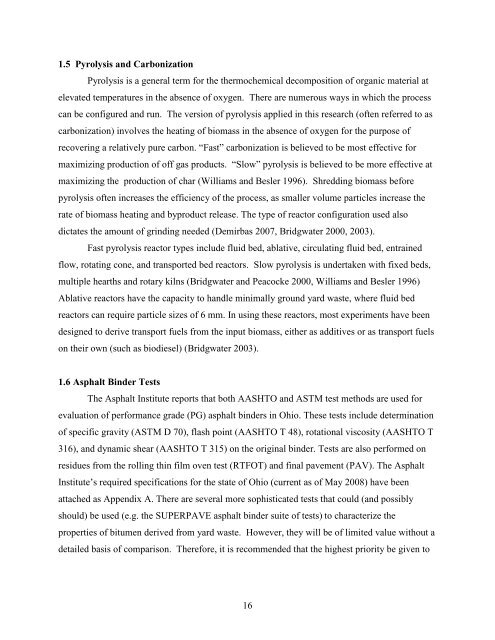Final Report - Ohio Department of Transportation
Final Report - Ohio Department of Transportation
Final Report - Ohio Department of Transportation
Create successful ePaper yourself
Turn your PDF publications into a flip-book with our unique Google optimized e-Paper software.
1.5 Pyrolysis and Carbonization<br />
Pyrolysis is a general term for the thermochemical decomposition <strong>of</strong> organic material at<br />
elevated temperatures in the absence <strong>of</strong> oxygen. There are numerous ways in which the process<br />
can be configured and run. The version <strong>of</strong> pyrolysis applied in this research (<strong>of</strong>ten referred to as<br />
carbonization) involves the heating <strong>of</strong> biomass in the absence <strong>of</strong> oxygen for the purpose <strong>of</strong><br />
recovering a relatively pure carbon. “Fast” carbonization is believed to be most effective for<br />
maximizing production <strong>of</strong> <strong>of</strong>f gas products. “Slow” pyrolysis is believed to be more effective at<br />
maximizing the production <strong>of</strong> char (Williams and Besler 1996). Shredding biomass before<br />
pyrolysis <strong>of</strong>ten increases the efficiency <strong>of</strong> the process, as smaller volume particles increase the<br />
rate <strong>of</strong> biomass heating and byproduct release. The type <strong>of</strong> reactor configuration used also<br />
dictates the amount <strong>of</strong> grinding needed (Demirbas 2007, Bridgwater 2000, 2003).<br />
Fast pyrolysis reactor types include fluid bed, ablative, circulating fluid bed, entrained<br />
flow, rotating cone, and transported bed reactors. Slow pyrolysis is undertaken with fixed beds,<br />
multiple hearths and rotary kilns (Bridgwater and Peacocke 2000, Williams and Besler 1996)<br />
Ablative reactors have the capacity to handle minimally ground yard waste, where fluid bed<br />
reactors can require particle sizes <strong>of</strong> 6 mm. In using these reactors, most experiments have been<br />
designed to derive transport fuels from the input biomass, either as additives or as transport fuels<br />
on their own (such as biodiesel) (Bridgwater 2003).<br />
1.6 Asphalt Binder Tests<br />
The Asphalt Institute reports that both AASHTO and ASTM test methods are used for<br />
evaluation <strong>of</strong> performance grade (PG) asphalt binders in <strong>Ohio</strong>. These tests include determination<br />
<strong>of</strong> specific gravity (ASTM D 70), flash point (AASHTO T 48), rotational viscosity (AASHTO T<br />
316), and dynamic shear (AASHTO T 315) on the original binder. Tests are also performed on<br />
residues from the rolling thin film oven test (RTFOT) and final pavement (PAV). The Asphalt<br />
Institute’s required specifications for the state <strong>of</strong> <strong>Ohio</strong> (current as <strong>of</strong> May 2008) have been<br />
attached as Appendix A. There are several more sophisticated tests that could (and possibly<br />
should) be used (e.g. the SUPERPAVE asphalt binder suite <strong>of</strong> tests) to characterize the<br />
properties <strong>of</strong> bitumen derived from yard waste. However, they will be <strong>of</strong> limited value without a<br />
detailed basis <strong>of</strong> comparison. Therefore, it is recommended that the highest priority be given to<br />
16
















